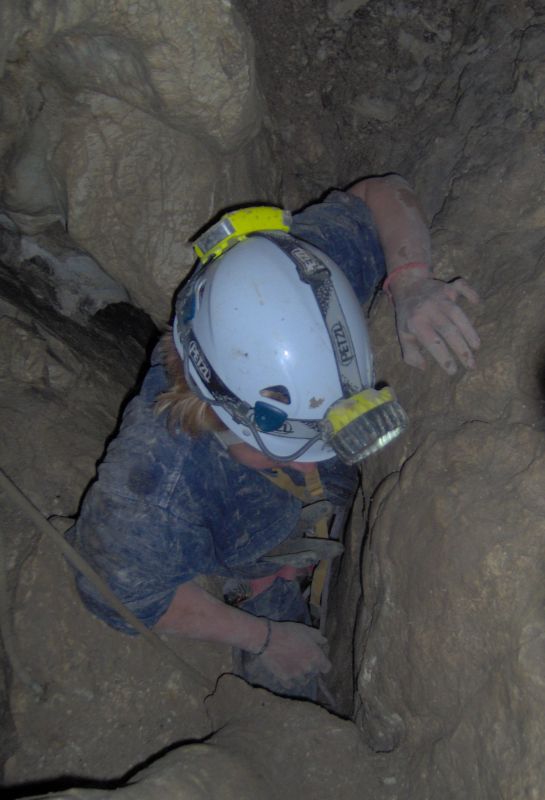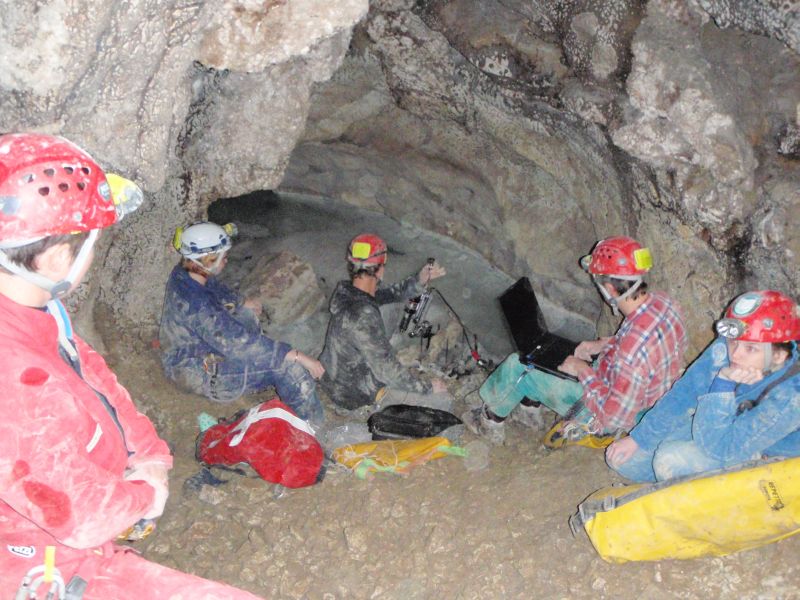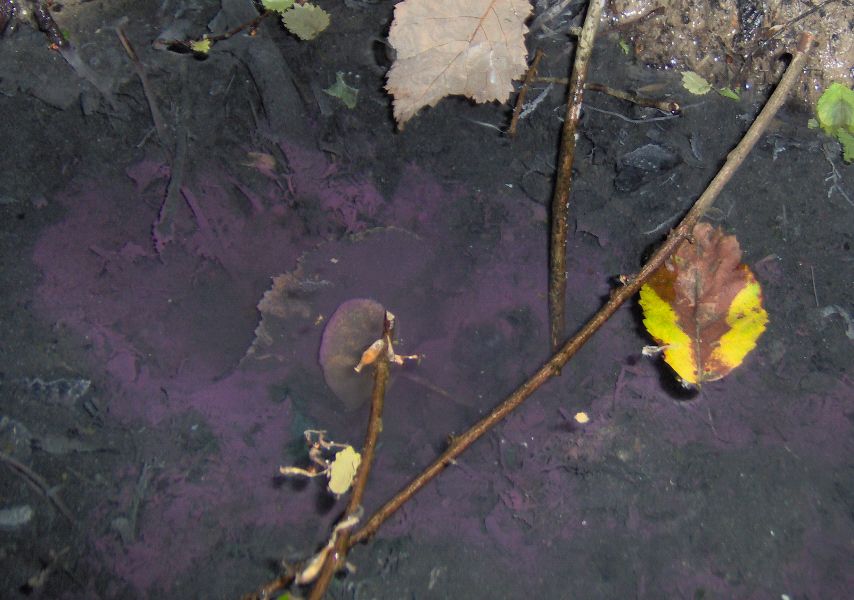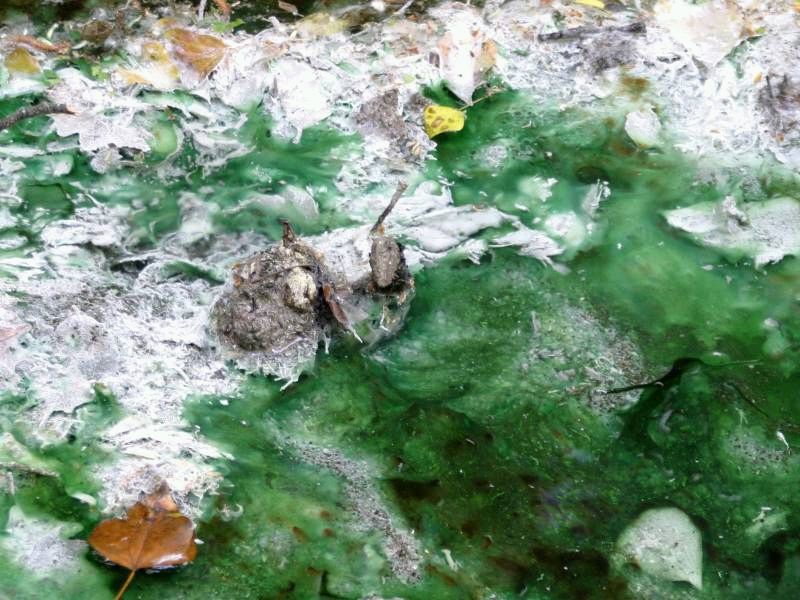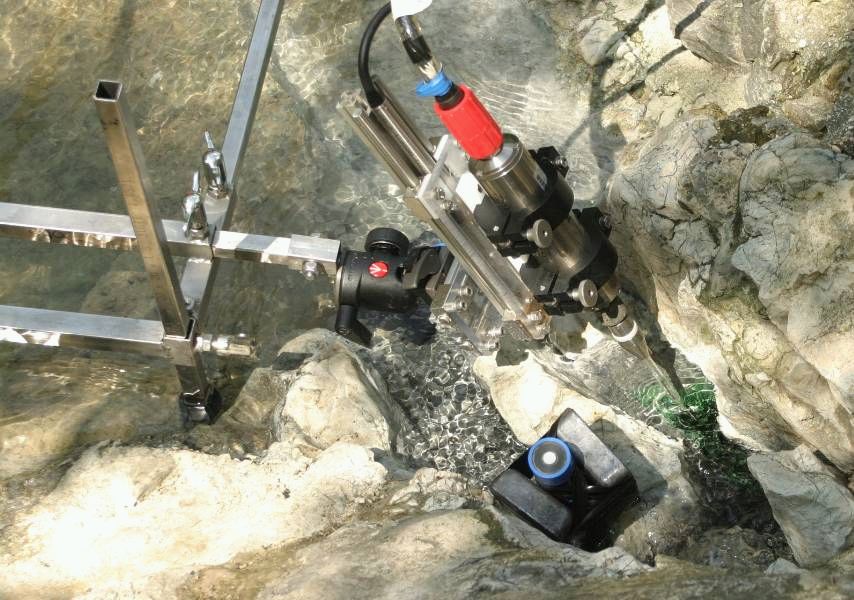Page path:
- Press Office
- Press releases 2009
- 12.11.2009 Hidden Treasures
12.11.2009 Hidden Treasures
Hidden treasures in subterranean sulfidic springs
Scientists of the Max Planck Institute for Marine Microbiology and the Pennsylvania State University explore microorganisms in subterranean sulfidic springs of the largest limestone cave system in Italy, le Grotte di Frasassi. The physically and geochemically isolated microbial populations in the sulfidic cave ecosystem provide an opportunity to study early Earth microbial evolution and biogeochemistry.
Tourists walk through a long tunnel and pause in suspense behind a massive metal door before their views expand across the stunning, over 200 meter high main dome of “Grotta Grande del Vento”, the Big Wind Cave. During the next hour, they gaze in awe at the giant stalactites and stalagmites as the tour guide explains many of the mysteries of the dark and cold underworld in one of the largest caves in the world. But the gorge of Frasassi in Genga (Ancona), located in the heart of the Natural Park of Gola della Rossa and Frasassi, holds also other secrets than the 1.5 km long tourist passage. With the subterranean cave system extending over 30 km on eight different geological levels, there is plenty more to explore.
In May and September 2009, a group of researchers around Dr. Lubos Polerecky from the Max Planck Institute (MPI) for Marine Microbiology in Bremen, Germany, visited the Frasassi caves. They joined their colleagues from the Pennsylvania State University to investigate a possible involvement of microorganisms in the cave formation. With the aid of professional cavers and the local geologists Dr. Sandro Montanari and Simone Cerioni, the scientists squeezed themselves and their equipment through narrow holes and passages into parts of the cave far beyond those accessible for tourists. The MPI scientists are collaborating on this project with American geomicrobiologists led by Dr. Jennifer Macalady, who have been investigating the microorganisms living in the dark and sulfidic subsurface world of the Frasassi cave since 2004. The goal of the scientists is to understand the role of bacteria in this extreme ecosystem, where light is absent, oxygen is scarce, and hydrogen sulfide is plentiful (see more info in box).
Scientists of the Max Planck Institute for Marine Microbiology and the Pennsylvania State University explore microorganisms in subterranean sulfidic springs of the largest limestone cave system in Italy, le Grotte di Frasassi. The physically and geochemically isolated microbial populations in the sulfidic cave ecosystem provide an opportunity to study early Earth microbial evolution and biogeochemistry.
Tourists walk through a long tunnel and pause in suspense behind a massive metal door before their views expand across the stunning, over 200 meter high main dome of “Grotta Grande del Vento”, the Big Wind Cave. During the next hour, they gaze in awe at the giant stalactites and stalagmites as the tour guide explains many of the mysteries of the dark and cold underworld in one of the largest caves in the world. But the gorge of Frasassi in Genga (Ancona), located in the heart of the Natural Park of Gola della Rossa and Frasassi, holds also other secrets than the 1.5 km long tourist passage. With the subterranean cave system extending over 30 km on eight different geological levels, there is plenty more to explore.
In May and September 2009, a group of researchers around Dr. Lubos Polerecky from the Max Planck Institute (MPI) for Marine Microbiology in Bremen, Germany, visited the Frasassi caves. They joined their colleagues from the Pennsylvania State University to investigate a possible involvement of microorganisms in the cave formation. With the aid of professional cavers and the local geologists Dr. Sandro Montanari and Simone Cerioni, the scientists squeezed themselves and their equipment through narrow holes and passages into parts of the cave far beyond those accessible for tourists. The MPI scientists are collaborating on this project with American geomicrobiologists led by Dr. Jennifer Macalady, who have been investigating the microorganisms living in the dark and sulfidic subsurface world of the Frasassi cave since 2004. The goal of the scientists is to understand the role of bacteria in this extreme ecosystem, where light is absent, oxygen is scarce, and hydrogen sulfide is plentiful (see more info in box).
While the group of scientists around Dr. Macalady focuses on studying the microbial ecology in sulfidic springs inside the caves, Dr. Polerecky and his colleagues from the MPI in Bremen also investigate the colourful bacterial communities growing just outside the caves, where the sulfidic springs enter the sunlit world. “We were very lucky with the timing of this fieldtrip. At one sulfidic spring, we spent two weeks investigating the beautifully coloured mats of different phototrophic bacteria. Unfortunately, the lush colours and booming activity of our 'microbial paradise' disappeared a day after the spring gradually dried out”, said Dr. Lubos Polerecky. One pool was coloured pink because of a thick film of purple sulfur bacteria, another was dark green because of cyanobacteria. The different colours derive from different pigments inside the cells of phototrophic bacteria. Organisms with light harvesting pigments build biomass from carbon dioxide using light energy, similar to what plants do. However, bacteria living in illuminated sulfidic waters like these were here long-long before the plants. These phototrophic microorganisms are capable of anoxygenic photosynthesis; instead of water, which is used in oxygenic photosynthesis, they use sulfide to gain electrons for the reduction of carbon dioxide.
Judith Klatt, another researcher at the MPI in Bremen, determines the activity of the purple sulfur bacteria under different conditions. “It must be a paradise for sulfur oxidizing bacteria”, she stated. During further investigations in the sunlit sulfidic pools, the researches found specimens of filamentous chemolithotrophs and photolithotrophs arranged in peculiar patterns. “We want to understand how the bacteria find their niche in this environmental setting and whether they interact with each other in a competitive or cooperative way”, explains Dr. Polerecky. Preliminary measurements with a diver operated motorized microsensor system and hyperspectral imaging by Stefan Häusler, another MPI scientist, already gave interesting insights into the lifestyle of the cyanobacteria there. These bacteria seem to outcompete other phototrophs by being able to carry out simultaneously anoxygenic and oxygenic photosynthesis.
“This ecosystem is so exciting! Settings similar to these probably existed on early Earth 2.8 billion years ago, when cyanobacteria began dominating our planet, generating vast amounts of oxygen which eventually gave raise to the evolution of much more diverse forms of life, including ours. Here we hope to find out some of the mechanisms how this might have happened”, concludes Lubos Polerecky. Back at the entrance to the caves, the tourists do not suspect any of this. Instead, they sip on the 'stinky water' they have just collected from the spring, exactly as visitors to this region have been doing since the times of the Romans.
Susanne Borgwardt
For further information please contact:
Dr. Lubos Polerecky, Tel: 0421 2028-834, [Bitte aktivieren Sie Javascript]
or the MPI press officers:
Dr. Manfred Schlösser, Tel: 0421 2028-704, [Bitte aktivieren Sie Javascript]
Dr. Susanne Borgwardt, Tel: 0421 2028-704, [Bitte aktivieren Sie Javascript]
Participating institutions:
Max Planck Institute for Marine Microbiology, Celsiusstrasse 1, 28359 Bremen, Germany
The Pennsylvania State University, Department of Geosciences, 210 Deike Building, University Park, PA 16802, USA
Osservatorio Geologico di Coldigioco, Frontale di Apiro, Italy
Judith Klatt, another researcher at the MPI in Bremen, determines the activity of the purple sulfur bacteria under different conditions. “It must be a paradise for sulfur oxidizing bacteria”, she stated. During further investigations in the sunlit sulfidic pools, the researches found specimens of filamentous chemolithotrophs and photolithotrophs arranged in peculiar patterns. “We want to understand how the bacteria find their niche in this environmental setting and whether they interact with each other in a competitive or cooperative way”, explains Dr. Polerecky. Preliminary measurements with a diver operated motorized microsensor system and hyperspectral imaging by Stefan Häusler, another MPI scientist, already gave interesting insights into the lifestyle of the cyanobacteria there. These bacteria seem to outcompete other phototrophs by being able to carry out simultaneously anoxygenic and oxygenic photosynthesis.
“This ecosystem is so exciting! Settings similar to these probably existed on early Earth 2.8 billion years ago, when cyanobacteria began dominating our planet, generating vast amounts of oxygen which eventually gave raise to the evolution of much more diverse forms of life, including ours. Here we hope to find out some of the mechanisms how this might have happened”, concludes Lubos Polerecky. Back at the entrance to the caves, the tourists do not suspect any of this. Instead, they sip on the 'stinky water' they have just collected from the spring, exactly as visitors to this region have been doing since the times of the Romans.
Susanne Borgwardt
For further information please contact:
Dr. Lubos Polerecky, Tel: 0421 2028-834, [Bitte aktivieren Sie Javascript]
or the MPI press officers:
Dr. Manfred Schlösser, Tel: 0421 2028-704, [Bitte aktivieren Sie Javascript]
Dr. Susanne Borgwardt, Tel: 0421 2028-704, [Bitte aktivieren Sie Javascript]
Participating institutions:
Max Planck Institute for Marine Microbiology, Celsiusstrasse 1, 28359 Bremen, Germany
The Pennsylvania State University, Department of Geosciences, 210 Deike Building, University Park, PA 16802, USA
Osservatorio Geologico di Coldigioco, Frontale di Apiro, Italy
Judith Klatt enters the sulfidic caves through a small hole in the rocks (source: Max Planck Institute for Marine Microbiology and Pennsylvania State University)
Scientists of the Max Planck Institute for Marine Microbiology and researchers from the Pennsylvania State University at work in one of the hidden caves (source: Max Planck Institute for Marine Microbiology and Pennsylvania State University)
Purple sulfur bacteria in a pool of the sulfidic spring (source: Max Planck Institute for Marine Microbiology and Pennsylvania State University)
Sulfide oxidizers paradise: thick mats of chemolitotrophic and phototrophic sulfide oxidizing bacteria near the exit of the sulfidic spring emerging from the Frasassi cave system (source: Max Planck Institute for Marine Microbiology and Pennsylvania State University)
A portable microsensor system (DOMS) used for the study of bacterial activity in the sulfidic springs (source: Max Planck Institute for Marine Microbiology)

